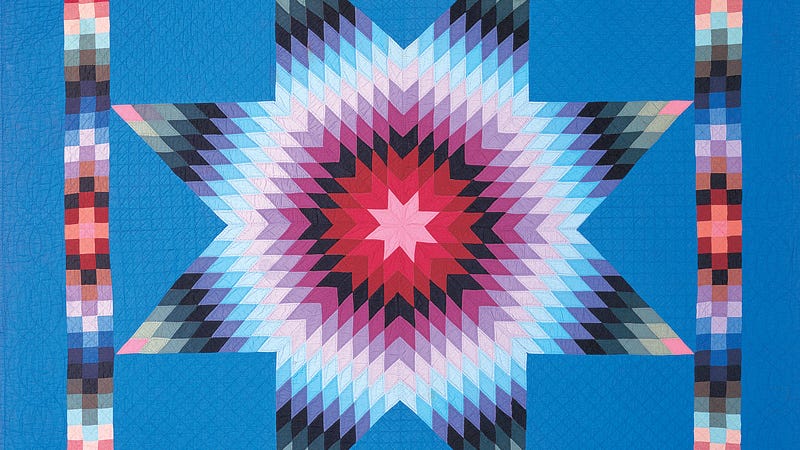Amish Abstractions: Quilts from the Collection of Faith and Stephen Brown
Apr 1, 2009
Amish Abstractions: Quilts from the Collection of Faith and Stephen Brown
San Francisco, April 2009—The Amish have been referred to as plain people, but there is nothing plain about their quilts. The artistry of the Amish tradition will be on full display at the de Young when the Fine Arts Museums of San Francisco (FAMSF) presents Amish Abstractions: Quilts from the Collection of Faith and Stephen Brown in the Caroline and H. McCoy Jones Textile Gallery. The exhibition, which opens November 14, 2009, features 48 full-size and crib quilts that showcase the diversity of the Amish quilt tradition, as well as the connoisseurship of collectors Faith and Stephen Brown.
Amish faith embodies principles of simplicity, humility, discipline, and community, yet Amish quilts are anything but humble. Using a rich color palette and bold patterns, the quilts are visual distillations of Amish culture and a truly unique contribution to American textile history. The works’ abstract patterns complement their craftsmanship and complexity. On first encountering Amish quilts, the Browns recall, “We were amazed by the bold graphics and striking colors, the very opposite of what we had expected. And we couldn’t get over the way some quilts seemed to anticipate abstract artists such as Josef Albers, Victor Vasarely, Frank Stella, Mark Rothko, Sol LeWitt, and Ellsworth Kelly, among others.”
The Exhibition
The quilts in the exhibition originated in communities throughout Pennsylvania and the Midwest and date from the 1880s to the 1940s, the height of Amish quilt production. Exhibition curator Jill D’Alessandro of FAMSF explains, “Although Amish women first learned quiltmaking from their ‘English’ (non-Amish) neighbors, they quickly developed a unique sensibility of their own, coupling distinctive choices of quilt patterns and fabrics with unusual spatial arrangements.”
The Amish approach to quiltmaking is informed by social structure and religious belief, and each community has adopted distinctive methods and techniques. It is commonly believed that the conservative Old Order Amish of Lancaster County, Pennsylvania were the first Amish to make quilts. Their quilts are renowned for their high-quality wool and surprising color choices; common Lancaster County patterns include Center Diamond, Bars, and Sunshine and Shadow.
The largest Amish settlement in the United States is in Holmes County, Ohio. The Holmes County community is less conservative than the Lancaster community, and the diverse quilts of Holmes County reflect this. The women of Holmes County often used black as a background color to set off the jewel-like hues of their piecework, a choice rarely made by mainstream American quiltmakers. Common patterns used among Holmes County Amish include Roman Stripe, Ocean Waves, Bowtie, and Tumbling Blocks.
The exhibition represents FAMSF’s longtime commitment to the art of quiltmaking. In 1990 the Museums worked with the Esprit Collection to organize the landmark exhibition Amish: The Art of the Quilt. In 2006, the de Young presented The Quilts of Gee’s Bend, the artistic legacy of four generations of African American quiltmakers from the small rural community of Gee’s Bend, Alabama. “The Museums have long recognized the important place of quiltmaking in our social and artistic heritage,” says John Buchanan, director of FAMSF. “Amish Abstractions builds upon previous exhibitions to demonstrate without a doubt the significance of the quilt in the American story.”
The Amish Context
The Amish represent a highly conservative branch of Protestantism with origins in Switzerland and Germany. Established in 1693 by Jakob Ammann, the Amish doctrine is based on creating a community apart from the rest of society. This community of believers makes no separation between secular and religious activities, holding that spiritual redemption is found in the submission of the individual to the group. The first wave of Amish immigrated to America between 1737 and 1754, settling on farms in Pennsylvania and, later, throughout the Midwest. Living largely apart from mainstream culture, the Amish reject most modern conveniences in favor of a quiet, ordered life that is reflected in their farms, buildings, furnishings, gardens, and textiles.
Organization
Amish Abstractions: Quilts from the Collection of Faith and Stephen Brown is organized by FAMSF and Faith and Stephen Brown. The presenting curator is Jill D’Alessandro of FAMSF.
Catalogue
A new, fully illustrated catalogue, titled Amish Abstractions: Quilts from the Collection of Faith and Stephen Brown, accompanies the exhibition. The publication features contributions by three quilt experts: Joe Cunningham, a well-known quilt artist, author, and lecturer; Robert Shaw, a former curator at the Shelburne Museum in Vermont; and Janneken Smucker, a doctoral candidate at the University of Delaware specializing in quilts from the Amish and Mennonite traditions. The 128-page hardcover, published by Pomegranate Press in association with FAMSF, is available is the Museum Store.
de Young Visitor Information
The de Young, designed by Herzog & de Meuron and located in Golden Gate Park, showcases American art from the 17th through the 21st centuries, international contemporary art, textiles, and costumes, and art from the Americas, the Pacific, and Africa.
Golden Gate Park, 50 Hagiwara Tea Garden Drive
Hours:
Tuesday–Thursday, Saturday and Sunday: 9:30 am–5:15 pm. Friday: 9:30 am–8:45 pm. Closed on Monday.
Cafe open 9:30 am–4:30 pm.
Museum Store open 9:30 am–5:00 pm.
Admission:
$10 adults, $7 seniors, $6 youths 13–17 and students with a college I.D. Members and children under 12 are free. The first Tuesday of every month is free.
There will not be a special exhibition fee for Amish Abstractions.
The de Young is accessible to wheelchair users. For information, contact the ADA Coordinator: 415.750.7645 (voice).
